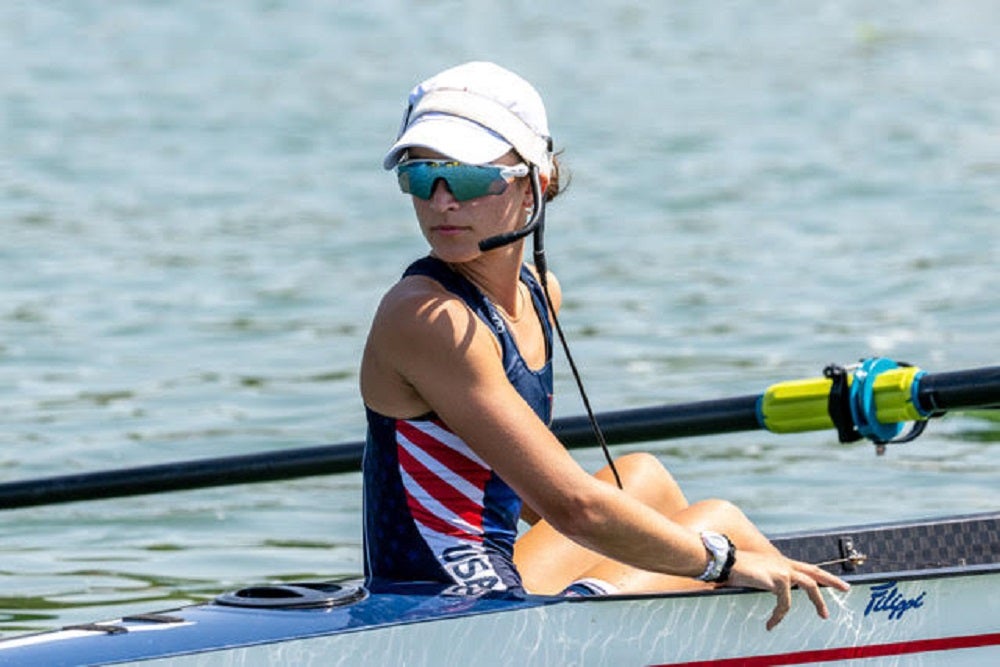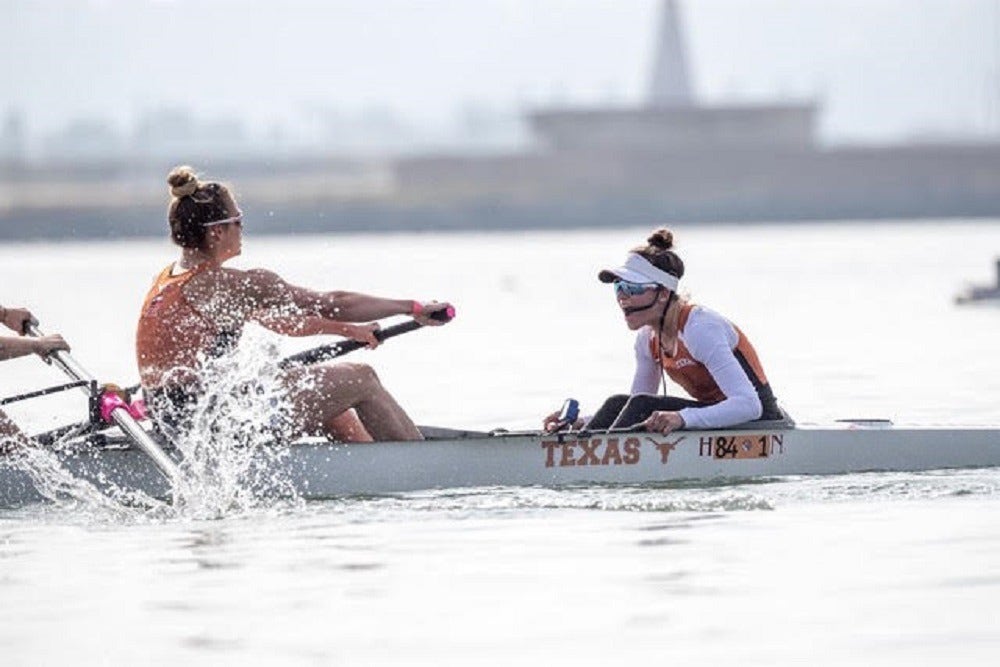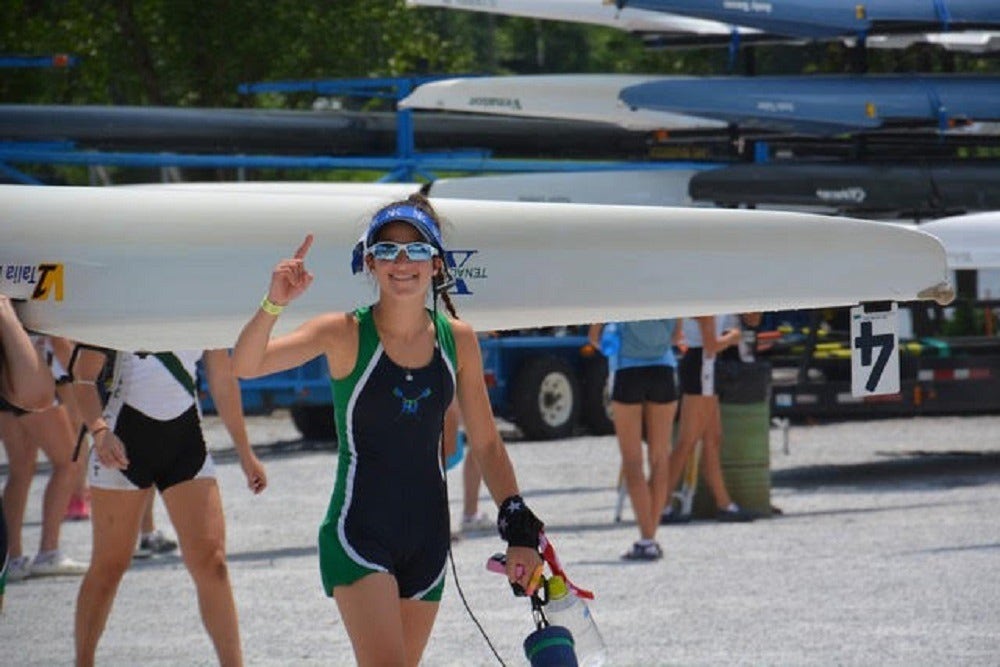Finding Her Coxing Voice – Rachel Rane

Coxing on the US collegiate scene is one of the most comprehensive challenges rowing can throw at a person. The sheer depth of competition, matched with the physical, emotional, and financial investment from athletes, spectators, coaches, and alumni, makes this a brutal and unforgiving arena of combat. To rise to the top and steer your crew to greatness requires a unique blend of conviction, confidence, and care.
Rachel Rane sat in the 1V at the University of Texas for three years, taking her crews to three successive NCAA national titles whilst also collecting gold at the U23 World Rowing Championships. Now at the University of Michigan, she caught up with NK to discuss how she found her coxing voice.
How did you first get into coxing?
I have a sister who is two years older than I, and while growing up, I pretty much did everything she did. We both played competitive softball, and when she got to high school, my parents encouraged her to try a fall sport since our class was huge—about 1,000 students. She figured she'd row in the fall and return to softball in the spring, but she ended up loving it and stuck with it through the end of the year.
I remember going to her national championship race with my family, it was my first ever regatta. I stood beside my twin brother and mom and watched her boat miss first place by just 0.2 seconds. It was so emotional—not just because she came second, but because of how intense, inspiring, and competitive it all was. By the time I got to high school, there was no question—I was hanging up my cleats during the school year. My brother had the same idea. It runs in the family!
What really kept you involved in the very beginning, and how has that evolved over the years?
I've been on competitive sports teams since I was seven, and I've always loved to compete. From the start, I knew that the longer I stayed in it, the more competitive it would get—and the more I'd want the ball. It's been a dream of mine to compete on the biggest stage, and that ambition still drives me today. I want to race the best with the best.
What truly made me fall in love with the sport was seeing my teammates push their bodies to the limit and knowing I could be their voice, guiding them through the pain, asking for more, and pushing them beyond what they thought they could do. It's such an emotional experience, riding the highs and lows together, and I wouldn't want to be anywhere else.
What was your first club like, and how important were they to your growth?
I coxed for New Trier High School in the northern suburbs of Chicago, one of the few public high schools in the Midwest competing at the youth national level. That program was the foundation of everything for me—it's where I decided to trade my softball cleats for an NK headset and commit to competing at the NCAA Division I level.
There wasn't a structured development system for coxswains, so I leaned on older coxswains, including my sister, and sought out outside resources to teach myself the ins and outs of the role. I had to figure out how to operate on land, manage the boat on the water, and truly understand what was expected of me. That experience forced me to be proactive, find solutions, and become a true student of the sport, skills that shaped me into the coxswain I am.

How would you define your coxing style?
I'd define my coxing style as simple, concise, and aggressive, while still being personal and conversational when it needs to be. A good coach can take something complex and make it simple, and I believe coxing is the same. At the elite level, there's no time for extra. Less is more.
It doesn't mean being cold or mechanical. My pushes have heart and fire, and how I deliver information is designed to fuel the boat. I cater to my crew, knowing what drives them, what they respond to, and how to get the most out of them when it matters. Clarity, intensity, and chemistry.
In your opinion, what is the most important attribute a successful coxswain must imbue?
In my opinion, one of the most important attributes of a successful coxswain is the ability to truly know your crew. It's not just about asking for more effort—it's about understanding how each rower responds to feedback, what they're working on, and how to give them responsibility in a way that makes the boat come together. A great coxswain doesn't just execute a race plan; they tailor it to their crew, knowing when and how to push the right buttons.
What has been your favourite coxing memory?
Entering my tenth year at it, picking just one is hard. Honestly, my favourite coxing memories come from the day-to-day grind—building speed, struggling together, and being in the boat with my teammates, some of my closest friends. Those moments, representing my school and country and working toward a shared goal, were the best part.
But if I had to pick one defining memory, it would be winning the first-ever national championship in programme history at Texas. That season was incredibly challenging, navigating COVID restrictions while still finding my place on the team. I made it my mission to be a sponge, taking in every piece of feedback, criticism, and advice to make both the boats I was in and the team better.

What was the biggest learning curve during your coxing journey, and how did you tackle it?
The biggest learning curve for me in college was figuring out how to harness my personality fully. Coming into freshman year, I had a lot of energy—a lot. Some of what I was saying was good and helpful, but my delivery needed work. I had to find balance in my tone, a way to lock my crew into my commands. But I struggled going back and forth—I was either off the walls or way too flat. Both were distracting.
I was told to be myself, which was the best way to lead. The key was learning to vary my tone naturally, bringing intensity when needed without losing authenticity. There's a balance. Ultimately, I stopped trying to say what I thought people wanted to hear and instead trusted what I knew and felt in the moment. That shift made me a more effective and confident leader in the boat.
What is the one bit of advice you'd give to a new cox trying to find his or her voice?
The best advice I ever received—and the advice I'd give to any new coxswain—is to be yourself. When you start coxing, there's often this pressure to say what you think rowers want to hear, but it's not a popularity contest. The best coxswains use their personality as an advantage. So, my advice is simple: don't try to change who you are. Use your personality to develop into the coxswain you're meant to be.
How crucial is high-quality equipment (like NK) to set you up for success?
High-quality equipment is crucial for success in rowing. Information is motivation—you need to know how fast you're going, time on the clock, meters, and where you are in the race. Without that data, you're at a disadvantage regarding strategy and execution.
When I work with the coxswains at Michigan, I talk about the three voices in rowing: the coach's voice, the coxswain's voice, and the voice inside the rower's head. In high-pressure moments, especially when things get hard, the coxswain's voice must cut through and override the doubt. That's why reliable equipment matters—if a speaker isn't working or the audio isn't clear, critical communication breaks down. That can be the difference between first and sixth place at the NCAA level and even at the Olympic level. To execute at the highest level, we need to be on the same page, and that starts with having equipment that allows for clear, consistent communication.





